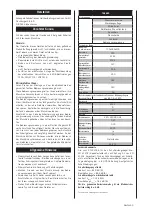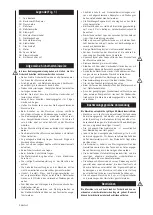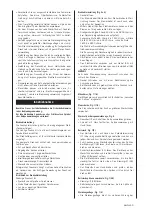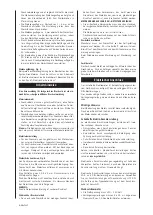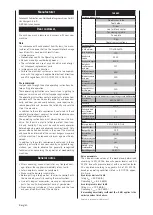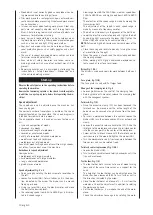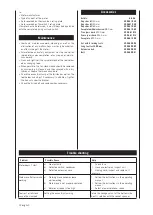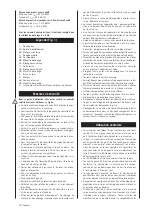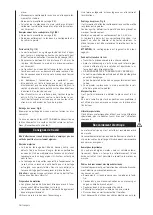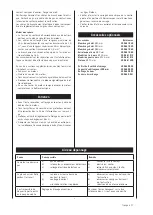
english 11
piece by hand.
• Once the eccentric clamp has been loosened, the holder
console can be moved along the entire length of the bed
and in the direction perpendicular to the workpiece. Fur-
thermore, the holder console can be tilted over approx.
45º to either side.
• To work with a plane surface, turn the tool holder 90º
and place up against the surface to be worked. Depend-
ing on the wood turning tool, place the tool holder up to
6 mm underneath the axis of the workpiece.
Use of wood turning tools, Fig. 5
Examples of how to use the tools when working with the
most frequent forms. Once the machine has been plugged
in, it is ready to be used. Observe the operating instruc-
tions in „Electrical connection“.
Operations
A perfect and sharp wood turner tool is a precondition for pro-
fessional wood-turning.
Selection of materials
• Wood to be turned must be of good quality and with-
out imperfections such as fissures against the grain, a
marred surface, or knots. Faulty wood tends to split and
becomes a risk for both the operator and the machine.
• Workpieces that have been glued together should only
be processed by experienced craftsmen. Because the
workpiece can explode as a result of developing cen-
trifugal force, turning such wood demands careful gluing
without weak points.
Note:
Beginners should first master fundamental skills by
working exclusively with solid material.
Preparation of the materials
• To turn long pieces of wood, the material must be cut
into a square form beforehand.
• To turn a cross-arm, the material must be cut to size in
its natural state as well. Saw out the rough form with a
band saw. An octagonal form is recommended for the
material so that vibrations are reduced.
Centering of the workpiece (Fig. 06)
Centering the prepared workpiece is an important opera-
tion to be performed before placing it into the machine.
Centering consists of measuring the middle point of the
workpiece and marking it with a center punch.
Make a depression of 1.5 to 2 mm in the middle point.
If the workpiece has not been centered exactly, strong vi-
brations will develop as a result of the imbalance. It is
possible that the workpiece could be hurled outward as a
result.
NOTE:
Exact centering of the workpiece produces smooth
concentricity.
While working with the turner
• Work with a rough workpiece should be conducted at low
speeds.
• Only after the wood has been pre-turned (the pre-turn-
ing operation is complete once the basic form of the
workpiece as well as an even concentricity have been
achieved) can the speed be raised.
TURN OFF AND UNPLUG THE MOTOR FIRST
• The live center must be readjusted from time to time
with the hand wheel. This operation only should be per-
formed when the motor has been turned off.
The tailstock center should rest firmly in the wood.
• Turn the workpiece by hand to check if it rests secured.
Marking of the workpiece
Sometimes the workpiece has to be taken out before it has
been completed. It is advantageous to mark the workpiece
and the driver with a pencil first.
When placing the workpiece back in the machine, match
the marks on the workpiece and the driver.
Specialized literature
Specialized shops offer appropriate specialized literature
about wood turning. They can be a great help for beginners
in their work as well as a source of ideas for experts.
Electrical connection
The installed electric motor is completely wired ready for
operation.
The customer’s connection to the power supply system,
and any extension cables that may be used, must conform
with local regulations.
Important remark:
The motor is automatically switched off in the event of an
overload. The motor can be switched on again after a cool-
ing down period that can vary.
Defective electrical connection cables
Electrical connection cables often suffer insulation dam-
age.
Possible causes are:
• Pinch points when connection cables are run through
window or door gaps.
• Kinks resulting from incorrect attachment or laying of
the connection cable.
• Cuts resulting from running over the connecting cable.
• Insulation damage resulting from forcefully pulling out
of the wall socket.
• Cracks through aging of insulation.
Such defective electrical connection cables must not be
used as the insulation damage makes them
extremely haz-
ardous.
Check electrical connection cables regularly for damage.
Make sure the cable is disconnected from the mains when
checking.
Electrical connection cables must comply with the regula-
tions applicable in your country.
Single-phase motor
• The mains voltage must coincide with the voltage speci-
fied on the motor’s rating plate.
• Extension cables up to a length of 25 m must have a
cross-section of 1.5 mm
2
, and beyond 25 m at least 2.5
mm
2
.
• The connection to the mains must be protected with a
16 A slow-acting fuse.
Only a qualified electrician is permitted to connect the ma-
chine and complete repairs on its electrical equipment.
In the event of enquiries please specify the following da-





